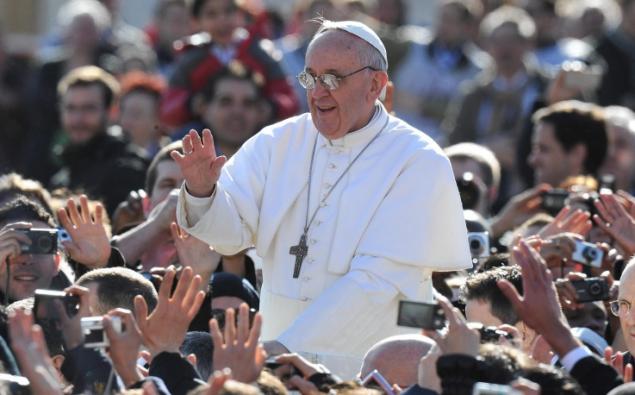Pope Francis is the 266th and current pope of the Roman Catholic Church, elected on 13 March 2013. As such, he is both head of the Church and sovereign of the Vatican City State.
The duties of the 266th successor to the throne of Saint Peter are wide-ranging.
The Pope’s regular Vatican appointments are:
- a weekly blessing for tourists and pilgrims every Sunday from the window of his private study overlooking Saint Peter’s Square
- a weekly general audience for some 5,000 pilgrims in a modern audience hall in winter and in the open air in Saint Peter’s Square in summer.
The Pope normally presides over religious celebrations of all the major church festivals of the year inside Saint Peter’s, including Christmas and Easter, when he also appears on the same balcony where he was proclaimed pope after his election to deliver his “Urbi Et Orbi” message to the city of Rome and to the world.
Past popes have celebrated Mass every morning in their private chapel before settling down at their desk to deal with correspondence.
The Pope has a small personal staff of nuns to run his household, to cook and clean, and a personal valet or butler. Pope Benedict XVI and Pope John Paul II both had two personal secretaries. He also has a team of speechwriters.
While Pope Emeritus Benedict lived a secluded life inside the Vatican (and plans to live an even more secluded existence in the former convent which is being prepared as his new home in a corner of the Vatican Gardens), Pope John Paul II lived a more gregarious existence, often inviting personal guests to attend his early morning mass and to share his breakfast. He also gave frequent lunch and dinner parties for visiting clergy and friends.
One of the duties of a pope is to meet at least once every five years with his more than 5,000 bishops from around the world – roughly 1,000 a year, or 20 a week.
Under church law they are obliged to visit Rome to report to the Pope on the state of their dioceses in what is called an “ad limina” (on the threshold of Saint Peter) visit. Pope Benedict XVI had just finished this exhaustive series of interviews with every Catholic bishop in the world, and was embarking on a second round just before his retirement.
Foreign travel is also, these days, among the Pope’s duties.

In contrast to the 19th Century Pope Pius IX and his immediate successors, Pope Francis is unlikely ever voluntarily to confine himself to his micro-state.
Pope Pius’ pontificate lasted for 32 years, the longest of all time. Although he was forced to leave Rome and seek temporary refuge at nearby Gaeta when revolution broke out in Rome in 1848, he angrily declared himself a “prisoner in the Vatican” when forced militarily to forfeit his temporal rule over the former papal states of central Italy after Italy became a unified state in 1870. He remained inside the walls of the Vatican until he died.
Pope Francis has already made several sorties into Rome in an unmarked car and is likely to continue the regular worldwide and Italian travels of his immediate predecessors. His first foreign visit is expected to be to his home country Argentina, and also to Brazil for a Catholic youth festival in Rio De Janeiro in July.
His first visit inside Italy could be to Assisi, the birthplace of the much loved patron saint of Italy, Saint Francis, by whose name the new Pope chose to be called.
The Pope also receives many visitors.
Traditional papal protocol is complicated and serves to isolate the Pope except when he officiates at these public ceremonies.
The Apostolic Palace, a fine Renaissance building next to Saint Peter’s Basilica, has suites of official reception rooms on its second floor, below the papal apartments. Here the Pope receives heads of state and official guests in his private library – groups of visitors range in size from four or five, to several hundred at a time.
Popes traditionally live in the spacious apartment reserved for their use on the top floor of the Apostolic Palace. This may not suit the new Pope who, as absolute monarch, is free to live where he will. When appointed archbishop of Buenos Aires, Pope Francis refused to live in the archbishop’s palace, preferring more simple accommodation.
Up to now Pope Francis has chosen to work from a hotel room inside Vatican City, rather than move directly into his palatial official quarters, which he finds excessively large.
